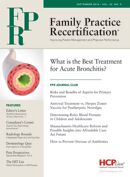Massachusetts Healthcare Reform and Possible Insights into Affordable Care Act Future
Implementation of Massachusetts health care reform reduced all-cause mortality and mortality from causes amenable to health care

Frank J. Domino, MD
Review
Sommers BD, Long SK, Baicker K. Changes in mortality after Massachusetts health care reform: A quasi-experimental study. Annals of Internal Medicine. 2014; 160:585-593.
Implementation of Massachusetts health care reform reduced all-cause mortality and mortality from causes amenable to health care
Study Methods
This unblinded, nonrandomized cohort study utilized a difference-in-differences analysis to look at mortality changes of its residents between pre reform (2001-2005) and post reform (2007-2010) of Massachusetts versus a control group from outside Massachusetts with similar demographics and economic conditions.
Patient Demographics
Adults aged 20-64 in Massachusetts and the control groups were organized into cells according to race, ethnicity, poverty, median household income, unemployment rate and uninsured rate.
Intervention (and control)
Massachusetts health care reform included Medicaid expansion, subsidized private plans for adults with incomes less than 100% of the federal poverty level, and expanded coverage subsidies for adults with incomes up to 300% of the federal poverty level. Fourteen Massachusetts counties with a population of 3.9 million were compared to 513 counties from 46 states and a total population of 44.3 million people with comparable demographics and mortality trends, pre reform and post reform.
Outcomes & Main Results
This analysis identified two outcomes to measure various subgroups of the Massachusetts population and control group. The primary outcome studied was change in all-cause mortality rate following Massachusetts health care reform. The secondary outcome studied was change in mortality secondary to conditions amenable to health care intervention such as bacterial infections, treatable cancers, diabetes, cardiovascular and cerebrovascular disease, and complications of common surgical procedures after reform.
The study showed a decrease in all-cause mortality of 2.9% (P = 0.003) in Massachusetts compared to the control group. The study also showed a decrease in mortality amenable to healthcare of 4.5% (P<0.001) in Massachusetts compared to the control group. A significant decline in mortality was not observed among those conditions not amenable to intervention (-2.0%; P = 0.26). The Massachusetts decline in all-cause mortality implied an absolute mortality change of -8.2 per 100,000 adults. The number needed to treat was 830 adults gaining insurance to prevent 1 death per year. The outcomes studied were best achieved among the non-white, poor and uninsured population of Massachusetts.
The study also analyzed changes in insurance coverage, access to care and general well-being. Insurance coverage improved with a 57% relative decrease in the uninsured rate. Access to care analysis revealed a 22% relative decrease in cost-related delays in care and a 13% relative decrease in lacking a usual source of care and annual preventive care visits. The Massachusetts population of this study reported improvement in general well-being. All of these findings were statistically significant (P < 0.001).
Conclusion
Massachusetts health care reform resulted in a statistically significant decrease in all-cause mortality and a decrease in mortality associated due to causes amenable to health care intervention among adults aged 20-64 during 2007-2010.
Commentary
Many factors influence health and wellbeing; as clinicians, we tend to focus on patient specific issues like tobacco and alcohol use, obesity, and exercise. Changing these factors leads to a decrease in all-cause mortality, but are hard to make happen for both the provider, and the patient.
Internationally, numerous studies have demonstrated how access to health care results in lower cancer deaths, infectious disease deaths, and pediatric asthma morbidity and mortality. This study has demonstrated how access to health care insurance in the US can lead to lower mortality from conditions that are amenable to treatment and covered by our health care system.
Massachusetts health care reform provides a provocative model for the potential impact of the Affordable Care Act. This analysis found that an increase in insurance coverage and access to care resulted in an improvement in self-reported well-being and can result in a reduction in all-cause mortality and mortality from causes amenable to health care.
Limitations of this study include the potential of environmental, cultural or economic variables playing a more prominent role than can be recognized. Massachusetts may not be representative of the rest of the nation. This study was not designed to link individual insurance coverage with individual reduction in mortality, so we can only conclude that the population’s risks improved. Another concern resides in just considering mortality just from causes “amenable to health care;” while the diseases are clearly identified, the term can be subjective and open to interpretation.
Regardless of politics, access to health care services will lead to a lowering of mortality and morbidity in the United States. The US spends more per capita than any other nation in the world (http://www.ncbi.nlm.nih.gov/books/NBK53944/) but our life expectancy is up to 4 years shorter than those countries (http://www.huffingtonpost.com/2013/10/03/health-care-costs-_n_3998425.html). From purely a fiscal viewpoint, extending health care to all makes financial sense. From the clinical perspective, this is intuitively obvious; and this study makes it empirically proven.
About the Author
Frank J. Domino, MD, is Professor and Pre-Doctoral Education Director for the Department of Family Medicine and Community Health at the University of Massachusetts Medical School in Worcester, MA. Domino is Editor-in-Chief of the 5-Minute Clinical Consult series (Lippincott Williams & Wilkins).
Additionally, he is Co-Author and Editor of the Epocrates LAB database, and author and editor to the MedPearls smartphone app. He presents nationally for the American Academy of Family Medicine and serves as the Family Physician Representative to the Harvard Medical School’s Continuing Education Committee.
